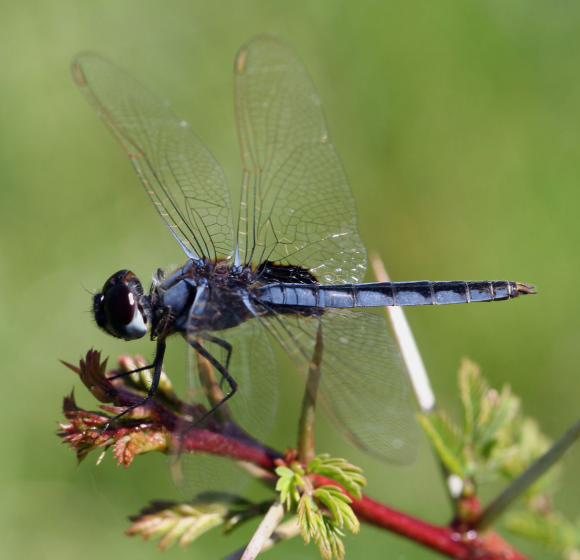Genus Urothemis Brauer, 1868
baskers
Type species: Urothemis bisignata Brauer, 1868 [= U. signata (Rambur, 1842)]
Introduction
Genus ranges from Australia across Asia to Africa, where five species occur. They are fairly large (hindwing 30-39 mm) bright red or blue pruinose dragonflies, that typically rest in ‘pennant’ position, i.e. at the tip of a conspicuous perch, with legs thrust forward and wings raised. This posture is also seen in some other libellulids with marked wings, e.g. Rhyothemis, Tramea and sometimes Trithemis. The bright red U. assignata and dark blue U. edwardsii are common at open marshes and ponds throughout Africa. The three other species are localised and poorly known: U. luciana is recorded irregularly in north-eastern South Africa; but probably the coastal plains of Mozambique or maybe even Madagascar are its stronghold. U. thomasi was described from southern Arabia and (as U. signata aethiopica) from northern Somalia. In the field it might be mistaken for Crocothemis erythraea, but has black on the legs. U. venata was only known from a photograph taken in 1983 near Kalima, eastern DR Congo, until it was collected recently in south-eastern Gabon and western Africa. It favours marshy ponds in or near forest and may be on the wing only in the wetter half of the year. [Adapted from Dijkstra & Clausnitzer 2014]
Diagnosis
Male of genus is similar to Macrodiplax by (a) size, Hw 29-38 mm; (b) arculus in all wings usually closer to Ax1 than Ax2; (c) sectors of arculus in Fw often separate at or just distal to arculus; (d) distal Ax in Fw complete, extends across subcosta like proximal Ax; (e) Fw discoidal field of 2 cell-rows at base; (f) Fw triangle always of 1 cell, subtriangle 1-3; subtriangle of 3 cells [2-3]; (g) 7-8 Ax in Fw [6-9]; (h) at most Hw base with large dark patch; (i) Hw base not so broad, cells evenly proportioned; (j) S4 without transverse ridge, although colour pattern or scar-like seam may indicate its position, there is no ridge of similar magnitude as transverse ridge of S3 and lateral carina of S4. However, differs by (3) hamule usually much longer than genital lobe, sometimes as long; (2) Hw base usually with dark brown marking, rarely orange; (1) Fw discoidal field narrows distally, 3-5 cells wide on wing border; (4) Abd with maturity either red with at most S5-9 black, or pruinose. [Adapted from Dijkstra & Clausnitzer 2014; this diagnosis not yet verified by author]

Urothemis edwardsii (Selys, 1849). Male © Hans-Joachim Clausnitzer

Urothemis assignata (Selys, 1872). Male © Hans-Joachim Clausnitzer
Map citation: Clausnitzer, V., K.-D.B. Dijkstra, R. Koch, J.-P. Boudot, W.R.T. Darwall, J. Kipping, B. Samraoui, M.J. Samways, J.P. Simaika & F. Suhling, 2012. Focus on African Freshwaters: hotspots of dragonfly diversity and conservation concern. Frontiers in Ecology and the Environment 10: 129-134.
References
- Dijkstra, K.-D.B, and Clausnitzer, V. (2014). The Dragonflies and Damselflies of Eastern Africa: handbook for all Odonata from Sudan to Zimbabwe. Studies in Afrotropical Zoology, 298, 1-264.
- Ris, F. (1921). The Odonata or Dragonflies of South Africa. Annals South African Museum, XVIII, 245-452. [PDF file]
- Pinhey, E.C.G. (1961). Dragonflies (Odonata) of Central Africa. Occasional Papers Rhodes-Livingstone Museum, 14: 1-97. [PDF file]
- Schouteden, H. (1934). Annales Musee Congo belge Zoologie 3 Section 2, 3, 1-84. [PDF file]
Citation: Dijkstra, K.-D.B (editor). African Dragonflies and Damselflies Online. http://addo.adu.org.za/ [2024-10-30].

